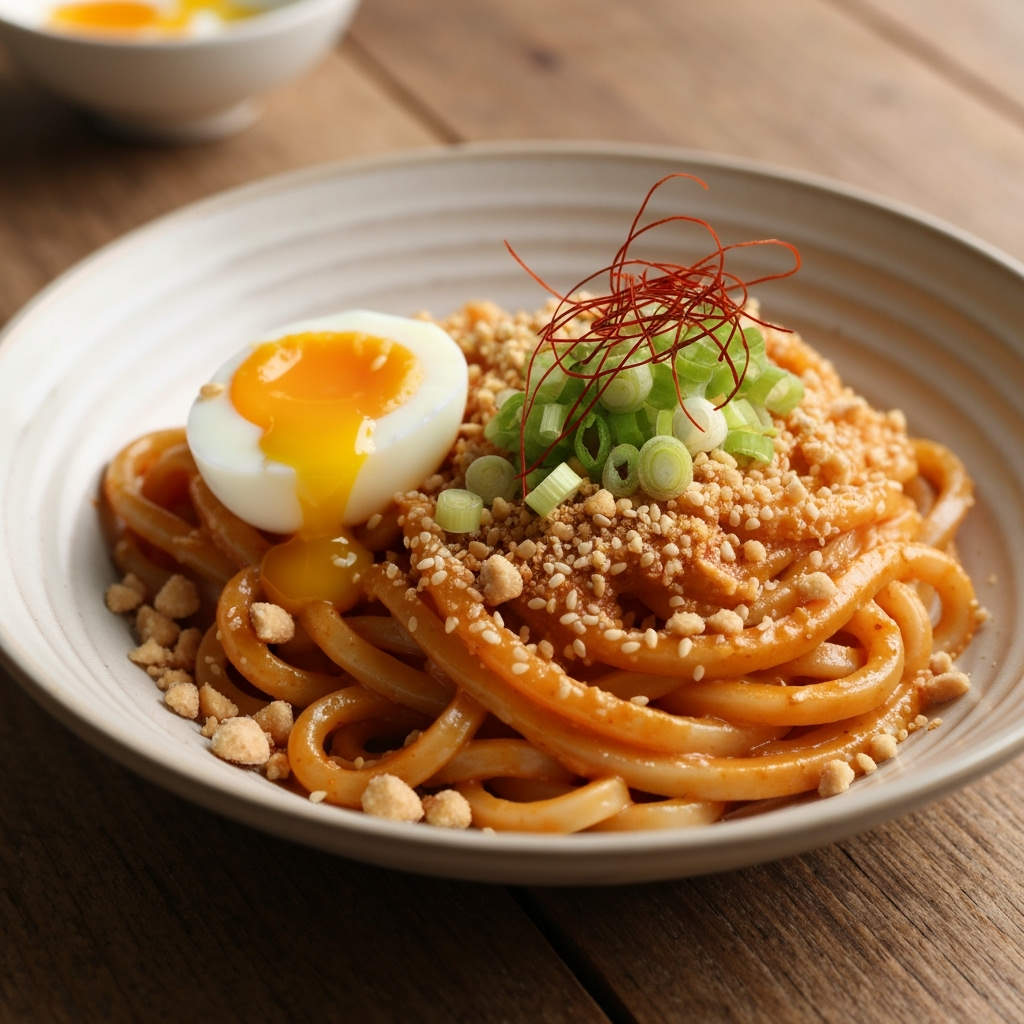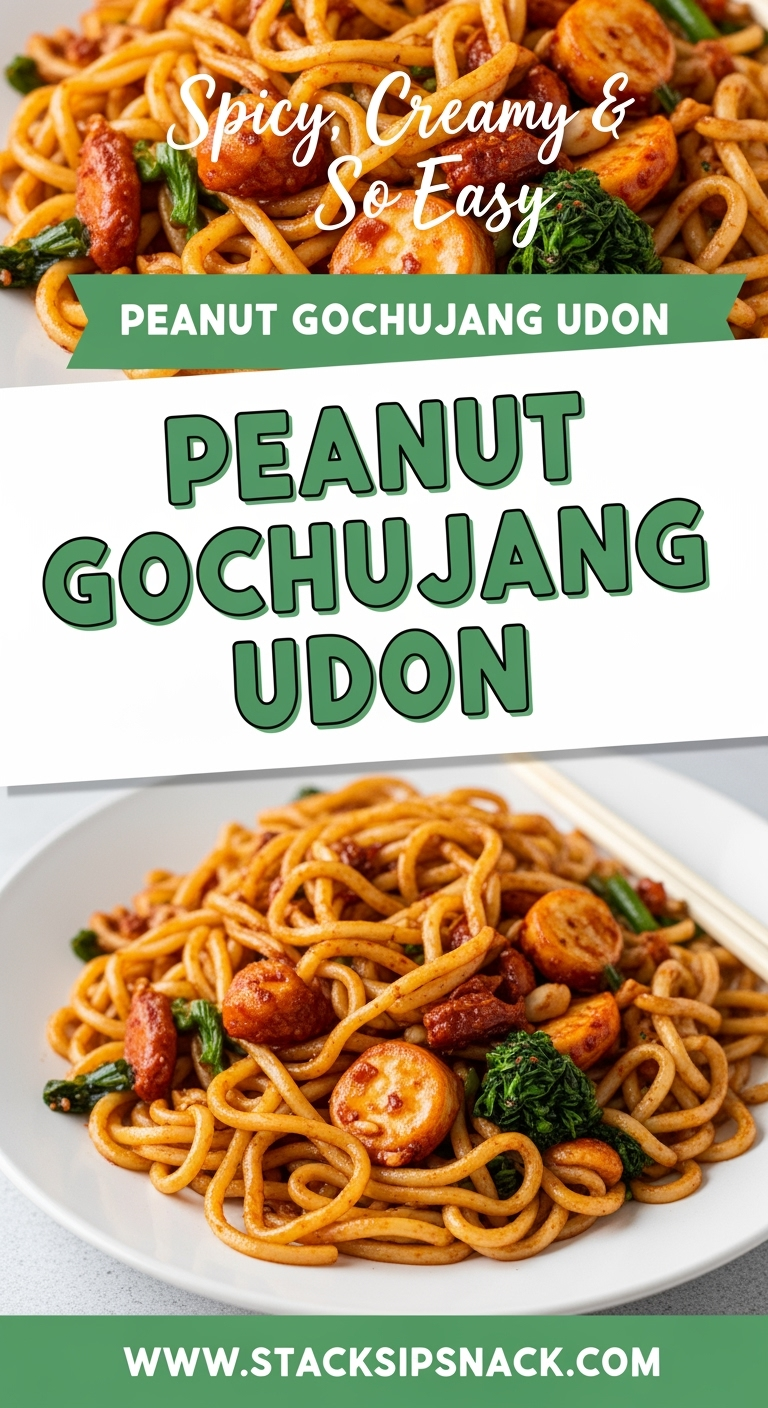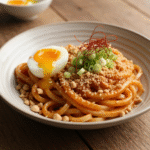There’s something deeply comforting about a bowl of noodles that comes together in minutes but tastes like it took hours. I first fell in love with the combination of spicy and nutty flavors during a busy weeknight when my pantry was looking sparse and my patience was even thinner. I needed something fast, flavorful, and filling. That’s when this Peanut Gochujang Udon was born—a happy accident that has since become a staple in our home. It’s the kind of meal that feels indulgent and exciting, yet is deceptively simple to make. If you’re searching for a weeknight dinner idea that packs a serious flavor punch without a long ingredient list, you’ve found it. This dish perfectly balances the rich, creamy depth of peanut butter with the complex, spicy-sweet kick of gochujang, all clinging to wonderfully chewy udon noodles.
Table of Contents
Peanut Gochujang Udon Ingredients
This Peanut Gochujang Udon recipe gets its incredible flavor from a short list of pantry-friendly ingredients. The sauce is the real star here, and it comes together in a flash.
- Udon Noodles: 2 packs (about 7 oz each) of fresh, frozen, or dried udon noodles. Fresh/frozen will give you that wonderfully chewy texture.
- Smooth Peanut Butter: 1/4 cup. Use the natural, runny kind if you have it for a smoother sauce.
- Gochujang Paste: 2 tablespoons. This is the heart of the spice and umami flavor.
- Soy Sauce: 2 tablespoons. For saltiness and depth. Use tamari for a gluten-free version.
- Rice Vinegar: 1 tablespoon. Adds a necessary bright, acidic note to cut through the richness.
- Toasted Sesame Oil: 1 teaspoon. Do not skip this! It provides a foundational nutty aroma.
- Maple Syrup or Honey: 1 tablespoon. A touch of sweetness to balance the heat.
- Garlic: 2 cloves, minced.
- Fresh Ginger: 1-inch piece, grated.
- Water: 1/4 to 1/3 cup, to thin the sauce to your desired consistency.
- For Topping: Sliced scallions, chopped peanuts, and sesame seeds.
Quick Timing Breakdown
- Prep Time: 5 minutes
- Cook Time: 10 minutes
- Total Time: 15 minutes
Yes, you read that right. From stovetop to bowl in about a quarter of an hour, making it even faster than waiting for delivery.
Step-by-Step Instructions for Peanut Gochujang Udon
Making this dish is a straightforward process. The key is to get your noodles cooking while you whip up the sauce.
- Cook the Udon Noodles: Bring a large pot of water to a boil. Cook the udon noodles according to the package directions. If using fresh or frozen udon, they often only need 1-2 minutes to heat through. Once cooked, drain and set aside. You can toss them with a tiny bit of oil to prevent sticking.
- Whisk the Sauce: While the water is heating or the noodles are cooking, combine the peanut butter, gochujang, soy sauce, rice vinegar, sesame oil, maple syrup, minced garlic, and grated ginger in a medium bowl. Start by whisking in 1/4 cup of water. The sauce will be thick at first but will loosen up as you whisk. Add more water, a tablespoon at a time, until it reaches a smooth, pourable consistency. If you love a saucier noodle, lean towards the 1/3 cup mark.
- Combine Noodles and Sauce: Add the drained, cooked udon noodles back to the warm pot (off the heat). Pour the peanut gochujang sauce over the top. Use tongs or two forks to toss everything together until every single noodle is gloriously coated in the creamy, spicy sauce.
- Serve Immediately: Divide the noodles into bowls and top generously with sliced scallions, chopped peanuts, and a sprinkle of sesame seeds.
Pro Tip: If your sauce seems too thick after combining with the noodles, simply add a splash of hot water from the noodle pot and toss again. This is an easy fix that gets the perfect saucy texture.
A Note on Nutrition
This Peanut Gochujang Udon is not just about flavor; it’s also a satisfying meal. A serving provides a good balance of carbohydrates from the udon for energy, plant-based protein and healthy fats from the peanut butter, and a dose of capsaicin from the gochujang, which can give your metabolism a little boost.
Equipment You’ll Need
You don’t need any fancy gadgets for this recipe. A large pot for boiling the noodles, a medium bowl for whisking the sauce, a whisk or fork, and a set of tongs for tossing are all that’s required. It’s the epitome of a simple, one-pot-and-a-bowl kind of meal.
Why You’ll Love This Peanut Gochujang Udon
- Speed Demon: It’s a legitimate 15-minute meal from start to finish, perfect for those “I’m-hungry-now” moments.
- Flavor Bomb: The combination of creamy, spicy, salty, and sweet is utterly addictive and far more complex than the effort required.
- Incredibly Versatile: This recipe is a fantastic base. Add any protein or veggies you have on hand.
- Pantry Hero: It relies heavily on shelf-stable ingredients, making it a reliable go-to when the fridge is looking bare.
If you enjoy the fusion of Korean flavors in a quick noodle format, you should definitely try our Korean Gochujang Noodles for another speedy option.
Healthier Alternatives and Swaps
This recipe is wonderfully adaptable to different dietary needs.
- Gluten-Free: Use 100% buckwheat soba noodles or gluten-free udon noodles and swap the soy sauce for tamari.
- Lower-Carb: Swap the udon for zucchini noodles (zoodles) or shirataki noodles. You may want to reduce the sauce quantity slightly as these noodles don’t absorb as much.
- Nut-Free: Substitute the peanut butter with tahini (sesame seed paste) or SunButter (sunflower seed butter). The flavor will be different but equally delicious.
- Vegan: The recipe is naturally vegan if you use maple syrup instead of honey.
For another creamy udon dish with a different flavor profile, our Decadent Creamy Miso Udon is a must-try.
Serving Your Spicy Noodle Bowl

While this Peanut Gochujang Udon is a complete meal on its own, you can easily build it out. For a more substantial dinner, top it with a soft-boiled egg, shredded rotisserie chicken, or pan-seared shrimp. For extra veggies, stir in some quickly sautéed bell peppers, spinach, or shredded carrots. The sauce is so robust it can handle all sorts of additions. Serving it family-style in a large bowl with all the toppings on the side lets everyone customize their own perfect bite.
Common Mistakes to Avoid
- Using the Wrong Peanut Butter: Avoid using sweetened peanut butter (like the kind often used for PB&J sandwiches) as it can make the sauce cloying. Natural, unsweetened peanut butter is best.
- Not Tasting the Gochujang First: Gochujang brands can vary in heat level. Taste a tiny bit first so you can adjust the amount to your personal spice tolerance.
- Overcooking the Noodles: Udon noodles are best when they’re chewy. Keep a close eye on them and test them a minute before the package suggests.
- Skipping the Acid: The rice vinegar is not optional. It’s crucial for balancing the rich, heavy flavors of the peanut butter and oil. Without it, the dish can taste one-dimensional.
If you’re a fan of quick, spicy noodle dishes, our 10-Minute Chili Oil Udon Noodles offer another fantastic weeknight solution.
Storing and Reheating Your Leftovers
This dish is best enjoyed fresh, but leftovers can be stored in an airtight container in the refrigerator for up to 2 days. The noodles will absorb the sauce, so when reheating, add a splash of water or broth to a skillet or microwave-safe bowl and gently warm the noodles, tossing until the sauce loosens up again. I do not recommend freezing this dish, as the creamy sauce can separate and the noodles can become mushy upon thawing.

Your New Go-To Noodle Night
This Peanut Gochujang Udon is more than just a recipe; it’s a reliable solution for busy days and a guaranteed way to satisfy a craving for something both comforting and exciting. It proves that you don’t need a long time or a complicated list to put a truly restaurant-worthy meal on the table. The creamy, spicy, and nutty sauce clinging to chewy udon noodles is a combination you’ll find yourself coming back to again and again.
I really hope this recipe becomes a fast favorite in your home, too. If you give it a try, I’d love to hear how it turned out for you! Leave a comment below and don’t forget to tag @Stacksipsnack on Pinterest so I can see your beautiful creations. For another incredibly fast peanut udon variation, check out our Creamy Gochujang Udon Noodles. Happy cooking
FAQs about Peanut Gochujang Udon
Print
Peanut Gochujang Udon
- Total Time: 15 minutes
- Yield: 2 servings 1x
Description
There’s something deeply comforting about a bowl of noodles that comes together in minutes but tastes like it took hours. This Peanut Gochujang Udon perfectly balances the rich, creamy depth of peanut butter with the complex, spicy-sweet kick of gochujang, all clinging to wonderfully chewy udon noodles.
Ingredients
- 2 packs (about 7 oz each) udon noodles (fresh, frozen, or dried)
- 1/4 cup smooth peanut butter (natural, runny kind preferred)
- 2 tablespoons gochujang paste
- 2 tablespoons soy sauce (use tamari for gluten-free)
- 1 tablespoon rice vinegar
- 1 teaspoon toasted sesame oil
- 1 tablespoon maple syrup or honey
- 2 cloves garlic, minced
- 1-inch piece fresh ginger, grated
- 1/4 to 1/3 cup water
- Sliced scallions, chopped peanuts, and sesame seeds for topping
Instructions
- Cook the Udon Noodles: Bring a large pot of water to a boil. Cook the udon noodles according to package directions. Once cooked, drain and set aside.
- Whisk the Sauce: While noodles cook, combine peanut butter, gochujang, soy sauce, rice vinegar, sesame oil, maple syrup, garlic, and ginger in a medium bowl. Whisk in 1/4 cup water, adding more as needed until sauce reaches pourable consistency.
- Combine Noodles and Sauce: Add drained udon noodles back to warm pot (off heat). Pour sauce over noodles and toss until thoroughly coated.
- Serve Immediately: Divide into bowls and top with scallions, peanuts, and sesame seeds.
Notes
Pro Tip: If sauce seems too thick after combining with noodles, add a splash of hot water from the noodle pot and toss again. Best enjoyed fresh, but leftovers can be stored in refrigerator for up to 2 days. Reheat with a splash of water to loosen sauce.
- Prep Time: 5 minutes
- Cook Time: 10 minutes
- Category: Main Course
- Method: Stovetop
- Cuisine: Korean Fusion
Nutrition
- Serving Size: 1 bowl
- Calories: 450
- Sugar: 8g
- Sodium: 850mg
- Fat: 15g
- Saturated Fat: 3g
- Unsaturated Fat: 10g
- Trans Fat: 0g
- Carbohydrates: 65g
- Fiber: 4g
- Protein: 12g
- Cholesterol: 0mg
💬 Let’s Stay Connected!
For daily recipes, kitchen tips, and exclusive content, follow me on:
👉 Facebook for behind-the-scenes & community fun
👉 Pinterest for visual inspiration & meal ideas
👉 X (Twitter) for quick tips & trending recipes
📲 Join the flavor journey, your next favorite recipe is just a follow away!










